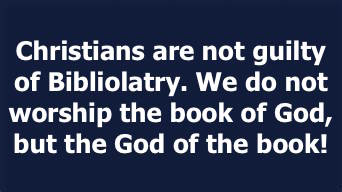The Original Manuscripts
 The first known system of writing carries us back to Mesopotamia around 3000 to 4000 BC. Here, the earliest form of writing was done in pictures. In ancient Egypt, writing also originated in pictures, which eventually became known as hieroglyphics. The first known system of writing carries us back to Mesopotamia around 3000 to 4000 BC. Here, the earliest form of writing was done in pictures. In ancient Egypt, writing also originated in pictures, which eventually became known as hieroglyphics.
Interestingly, the first known alphabet has been discovered by archeologists in the region of the Biblical Mount Sinai, where God gave Moses the Ten Commandments. These discovered inscriptions on monuments and rocks date back to around 1500 BC.
The Mosaic authorship of the first five books of the Bible, which was attested to by none other than our Lord Himself,1 was once disputed on the basis that writing was unknown to the ancient world during the time of Moses. However, today, thanks to archeological discoveries, which always prove rather than disprove the Bible, we know that writing did exist in Moses’ day and even predated the time of Moses.
The Bible makes reference to a number of different writing materials utilized by people in ancient times. It speaks of writing on stone, clay, leather, and papyrus.
In Palestine, the earliest known examples of writing have been found on stone. These include the so-called Gezar Calendar from the 10th century BC. and the Moabite Stone, which dates a century later. This agrees with what the Bible says about early writing. For instance, the Ten Commandments were written on stone tablets. Once again, we see, contrary to popular opinion, how archeological discoveries confirm rather than contradict the Bible.
In the area of the Tigris-Euphrates Rivers, clay was readily abundant. Huge libraries containing thousands of clay tablets have been unearthed from this part of the world. The clay was made into tablets when soft. The writing was impressed upon the soft tablets with a stylus. Then, finally, the tablets were baked in an oven.
Archeologists have discovered a clay tablet of the ancient city of Nippur, which is like the map of Jerusalem the ancient Prophet Ezekiel was commanded by God to sketch on a block of clay.2 Again, archeology is found, contrary to popular belief, to confirm rather than contradict the Bible’s reliability.
In the Old Testament period, the Jews wrote the Law on leather scrolls, from which they read in their synagogues. In the time of the New Testament, papyrus had become the preferred writing material. Papyrus gets its name from the papyrus plant, which formerly grew in abundance along the Nile River in Egypt.
From the stem of the papyrus plant thin strips were cut and laid side by side to form a sheet. A second layer was laid across the first and joined to it by moisture and pressure. After drying and polishing, the sheet was ready for use.
The New Testament’s smaller books, like Philemon and Jude, were undoubtedly written on a single sheet of papyrus. However, several papyrus sheets had to be joined to contain the larger books of the New Testament. To hold one of the longer books, like the Gospel of Luke or the book of Acts, a roll (scroll) of about 35 feet was required.
As long as the roll form was used, it was never possible to have the New Testament in one volume, since it would have required a roll of about 200 feet. Consequently, the New Testament, in its earliest stages, was contained on a collection of scrolls. These scrolls were safely stored in a cabinet or similar container.
In the first or second century AD, the papyrus roll began to give way to what is known as the papyrus codex. A codex is simply what we know today as a book. Still, whether in roll or codex form papyrus sheets were very fragile and subject to deterioration. As a result, none of the original manuscripts of the Bible have survived to our day.
We must pause at this point to ask a most apropos and unavoidable question. Why do none of the Bible’s original manuscripts exist today? Why were they not miraculously preserved by God? The answer to this question may be found in the fact that God wanted to prevent us from enshrining the original manuscripts of the Bible. God knew if the original manuscripts were preserved they would become a rival to Him for our reverence. In other words, we would become worshippers of the book of God rather than of the God of the book!
To prevent us from becoming guilty of Bibliolatry—worshiping God’s written Word, the Bible, rather than God’s Living Word, Jesus Christ—God prevented the preservation of the original manuscripts of the Scripture.
In Deuteronomy 34:1-8, we are told how God mysteriously buried Moses in a secret location on Mount Nebo. “Why,” we must ask, “did God want to keep the location of Moses’ sepulcher secret.” Was it not because He knew Moses’ sepulcher would be turned into a shrine by the Hebrews? Instead of worshipping Him, the God of Moses, the Lord knew His people would worship Moses, the servant of God.
People are so fickle, even the people of God, that we are ever prone to worship sacred writings or faithful servants rather than the God who inspires the writings or whom the faithful serve. Thus, to prevent us from being distracted from the worship of Him alone, God secretly buries a Moses and does not miraculously preserve the original manuscripts of His Word.
1 Luke 24:44
2 Ezekiel 4:1
|